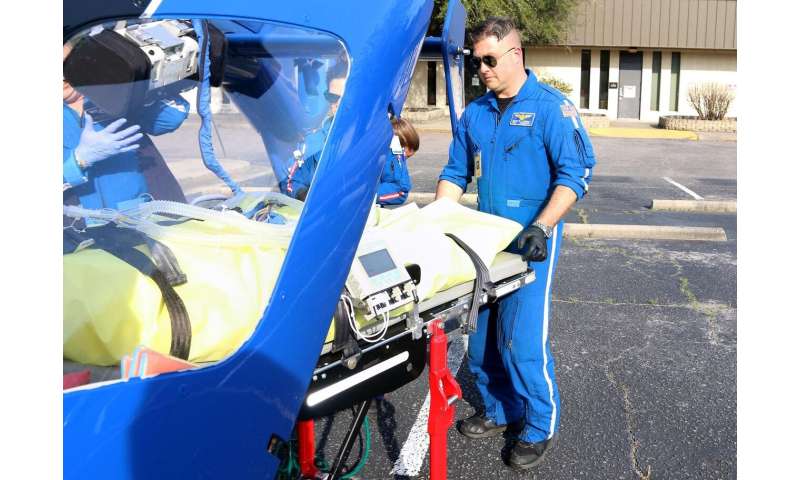
Seriously ill patients require serious, higher-level care, and sometimes patients must be transferred from one hospital to another to allow access to that care. For example, a patient may require procedures, tests or expertise that only an academic medical center can deliver. The benefits of such interhospital transfer (IHT) are believed to outweigh the risks, but at the same time, studies of national databases indicate that transferred patients have a higher risk of dying than patients admitted to the hospital locally through the emergency department. And with about 1.6 million patients being transferred between hospitals each year, this safety risk needs to be resolved as a top priority.
While national studies demonstrate worse outcomes for IHT patients, these studies are unable to control for patient-level details such as individual vital signs, laboratory values and specific disease processes, so it is difficult to conclude whether the worse outcomes are related to the transfer process itself or to undefined variables. A few detailed single-center studies controlling for these patient-level characteristics were performed in the 1980s and 1990s, but health care has changed enormously since then.
Marc Heincelman, M.D., a hospitalist and assistant professor at the Medical University of South Carolina (MUSC), notes that patient safety has become a major target over the last two decades, which has led to robust electronic health records, quality improvement initiatives focused on patient safety, and specialists—hospitalists—focused solely on inpatients.
Heincelman explains, “With the implementation of electronic health records, expansion of hospitalists, and enhanced focus on quality improvement and safety, further studies needed to be performed to look at patient-level characteristics associated with the transfer process.”
He thus chose to perform an updated study, recently published by the Journal of General Internal Medicine, to examine the safety of IHT within the modern health care system. He and his colleagues also wanted to examine the relationship between IHT and mortality at a detailed level that considered many patient characteristics. They wanted to determine if patient factors could explain why the risk of mortality increased or if the higher risk was even truly there once the patient factors were considered.
The research team started by separating data for about 9,000 patients admitted to the hospital between 2013 and 2014 into groups based on how the patients were admitted—via IHT, the emergency department or a clinic. Using data modeling with increasing levels of refinement, the researchers next examined the relationship between IHT and the risk of death. The first modeling step considered both the IHT status of the patients and the hospital service that received them. The second included patient demographic information, such as age, race, gender, zip code, income and insurance status. The third added specific disease processes, such as heart failure, kidney dysfunction, diabetes and others. And the fourth looked at individual vital signs and laboratory data present on hospital admission.
“We found two interesting things,” says Heincelman. “First, detailed patient-level variables do play a role in predicting mortality, and second, even after controlling for those variables, interhospital transfer itself is still associated with inpatient mortality.”
By looking at multiple layers of patient characteristics, the study pinpointed that vital signs and lab data play a role in the risk of mortality in IHT patients. While the overall mortality risk was about 2 times higher for IHT patients than for patients admitted via the emergency department, that risk changed to 1.7 times after patients’ vital signs and laboratory values were considered.
Heincelman points out that this observation already provides an opportunity for improvement. “It allows the accepting physician to just take a moment and ask, ‘Is there anything we need to do at the initial institution to stabilize them before we transfer them?'”
But even allowing for the effect of vital signs and lab values, outcomes for transfer patients are still worse than those for patients admitted through the emergency department. The reasons for this association are still unknown, but Heincelman plans to dig deeper to learn what other variables may be at play. He hopes that this will lead to better outcomes for patients who need to be transferred from one hospital to another.
He notes, “A seriously ill patient at a community hospital is still at risk for mortality there. So if we think that transfer is the right thing for the patient we’re going to do everything we can for them. The question is how can we make it as safe as possible, and the hope is that we can reduce the risk.”
Heincelman and colleagues hypothesize that many patients who require transfer are sicker than current scoring models indicate. But they also believe that the transfer process itself may be risky. They next plan to examine this process in detail, looking at factors like the day and time of transfer, the busyness of the admitting service during transfer, how much time elapses between the hospital accepting the patient and the actual arrival time, and communications between the doctor sending the patient and the doctor receiving the patient on the other end.
Source: Read Full Article
